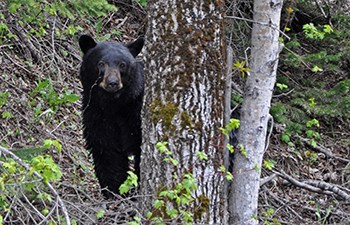
NPS Black BearsUrsus americanus Color: Can be black, blond, brown, or cinnamon in color Weight: Adult males 180-250lbs, sometimes up to 400lbs; females 120-180lbs Top speed: 35 mph Lifespan: Average is 18 years, some live as long as 25 years Appearance: Their snout is straighter from tip of nose to ears. Their claws are short (about 1.5 inches) and curved, making them good for climbing trees. Habitat: Black bears spend most of their time in forests but move around looking for food. They can also be found in avalanche chutes, mountain meadows, or areas where berry bushes are plentiful. Diet: A black bear's diet changes with the seasons. In the spring bears eat mostly grasses; in the summer they like leafy, green plants and fruits; and in the fall they look for berries and nuts. They will also eat fruits, insects, honey, eggs, carrion, rodents, and young deer or elk when available. Reproduction: Mating season is May-August. Females breed every 2-3 years and give birth to 1-3 cubs in their winter den in January or February. Cubs weigh 1lb. at birth but can weigh as much as 165lbs. (if good food sources are available) by their first fall. Cubs stay with their mother for about 2 years. Females often have their cubs when they are about 6 years old. 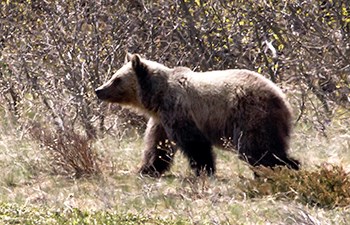
NPS/Tim Rains Grizzly BearsUrsus arctos On the east side of Glacier, some grizzlies spend all summer in the lowland meadows and aspen groves, returning to the high country only to hibernate. Others spend springtime in the valleys, dining on the succulent early growth, but then return to the high country for the rest of the growing season. Studies have shown that feeding habits are not a one-way energy exchange. Grizzlies use their long claws and powerful shoulder muscles to dig for glacier lilies in early summer. The digging releases nitrogen to the soil and glacier lilies in subsequent years are larger and more abundant in grizzly digs. Huckleberry seeds are spread in bear droppings, complete with the perfect fertilizer for germination. Listed as threatened in the contiguous United States and endangered in part of Canada, grizzly bears will normally avoid humans when possible. Human development of land in the region has resulted in habitat fragmentation for the species, while declining crops of whitebark pine nuts may affect their food availability. As grizzly bears have a very low reproductive rate, these pressures are seen as increasingly detrimental to maintaining healthy populations. Color: Can range from blonde to nearly black and sometimes have silver-tipped guard hairs that give them a grizzled look Weight: Adult males 300-440 lbs; females 250-280 lbs Top speed: 35 mph Lifespan: 15-25 years Appearance: Their snout is dished in and there is a noticeable hump above the shoulders. Their claws are about 4 inches long and slightly curved, making them good for digging. Habitat: Grizzly Bears spend most of their time in meadows but move around looking for food. They can also be found in, forests, avalanche chutes, and places where berry bushes or whitebark pine trees are plentiful. Diet: A grizzly's diet changes with the seasons. In the spring, they eat grasses, rodents, and carrion; in the summer they feed on leafy, green plants and flowers, insects, and roots, and in the fall they eat berries and pine nuts. They will also eat large and small mammals, fruit, bark, roots, and mushrooms when they are available. Reproduction: Mating season is May-early July. Females breed every 2-4 years and give birth to 1-3 cubs in their winter dens in January or February. Cubs weigh 1 lb. at birth and are nursed to about 20 lbs. before coming out of the den in April or May. They stay with their mother through the next 2 winters. Grizzlies are usually full grown in 4-6 years. Females have their first litter when they are about 5 years old. 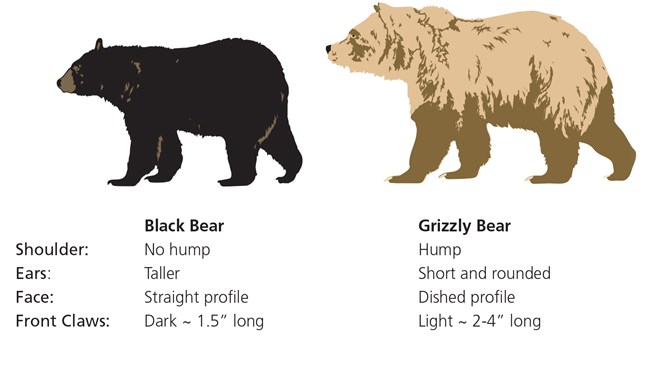
Size and/or color are not reliable indicators of species. Use the chart at right to help you tell the species apart. Bears are large and potentially dangerous animals. Read more about bear safety before hitting the trail. Report any bear or unusual animal sightings to the nearest ranger immediately.
Bear Research in Glacier
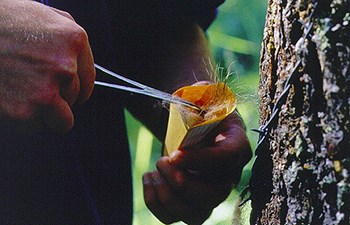
USGS DNA Sampling Pioneering studies of DNA in hair and scat have given scientists new tools for estimating bear population numbers in the park. Barbed wire hair snags were used to collect hair samples from grizzly bears throughout the Crown of the Continent Ecosystem as part of the Northern Divide Grizzly Bear Project. DNA was extracted from from bear hair collected along survey routes and from systematically positioned hair snag stations. This project used this technique in conjunction with statistical models to estimate the number of grizzly bears inhabiting the ecosystem, which includes Glacier National Park. Watch a short video on the grizzly research project. As a result of this project, and after collecting and analyzing a staggering 34,000 hair samples, the latest estimates hover around 300 grizzly bears and 600 black bears, but refinements are constantly improving the accuracy of the estimate. 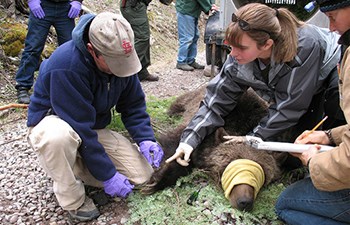
NPS Radio Collaring Radio collars are invaluable tools which allow bear researchers and managers to gather survival and reproductive data on individual bears. Once enough data is accumulated, it becomes possible to mathematically estimate trends in the grizzly population. Managers of the Northern Continental Divide Ecosystem (of which Glacier National Park is a part) are striving to keep 25 bears (primarily females with cubs) radio collared with state-of-the-art GPS/ARGOS collars. These collars locate themselves through the Global Positioning Satellite (GPS) system and then transmit their location to researchers through the ARGOS satellite system. This provides bear researchers and managers with invaluable data, including near real-time location information about individual bears. Peruse the Northern Rocky Mountain Science Center website for more information. Visit the NPS Bears webpage for more information regarding bear research and management at parks nationwide, for educational resources, and even to hear a gallery of bear sounds. |
Last updated: November 6, 2017
